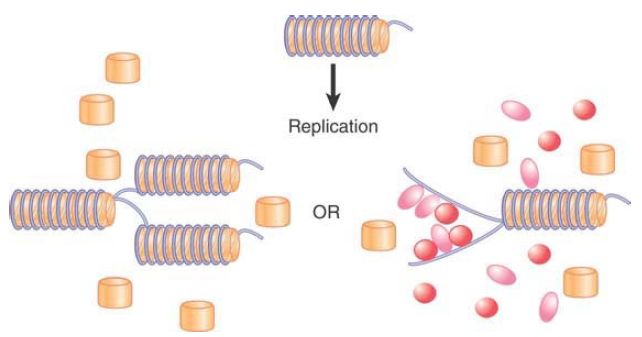


 النبات
النبات
 الحيوان
الحيوان
 الأحياء المجهرية
الأحياء المجهرية
 علم الأمراض
علم الأمراض
 التقانة الإحيائية
التقانة الإحيائية
 التقنية الحيوية المكروبية
التقنية الحيوية المكروبية
 التقنية الحياتية النانوية
التقنية الحياتية النانوية
 علم الأجنة
علم الأجنة
 الأحياء الجزيئي
الأحياء الجزيئي
 علم وظائف الأعضاء
علم وظائف الأعضاء
 الغدد
الغدد
 المضادات الحيوية
المضادات الحيوية|
Read More
Date: 9-12-2015
Date: 9-5-2021
Date: 2-5-2021
|
How Is a Gene Turned On?
Key concept
- Some transcription factors may compete with histones for DNA after passage of a replication fork.
- Some transcription factors can recognize their targets in closed chromatin to initiate activation.
- The genome is divided into domains by boundary elements (insulators).
- Insulators can block the spreading of chromatin modifications from one domain to another.
Multicellular eukaryotes typically begin life through the fertilization of an egg by a sperm. In both of these haploid gametes, but especially the sperm, the chromosomes are in super-condensed modified chromatin. Males of some species use positively charged polyamines, such as spermines and spermidines, to replace the histones in sperm chromatin; others include sperm-specific histone variants. Once the process of fusion of the two haploid nuclei is complete in the egg, genes are then activated in a cascade of regulatory events. The general question of how a gene in closed chromatin is turned on can be broken down into (at least) two parts: How is an individual gene that is wrapped up in condensed chromatin identified and targeted for activation? Furthermore, once histone modification and chromatin remodeling begin, how are those processes prevented from spreading to genes that should not be turned on?
First, imagine that replication is one mechanism by which closed chromatin can be disrupted in order to allow DNA-binding sequences to become accessible. Replication opens higher-order chromatin structure by temporarily displacing histone octamers.
The occupation of enhancer DNA sites on daughter strands subsequently can be viewed as competition between nucleosomes and gene regulators. Chromatin can be opened if transcription factors are present in high enough concentration, as shown in FIGURE 1. If the transcription factor concentration is low, then nucleosomes can bind and condense the region. This occurs in Xenopus embryos as oocyte-specific 5S ribosomal genes are repressed in the embryo after fertilization.

FIGURE 1. When replication disrupts chromatin structure, after the Y fork has passed, either chromatin can reform or transcription factors can bind and prevent chromatin formation.
Second, it is clear that some transcription factors can bind to their DNA target sequence in closed chromatin. The DNA exposed on the surface of the histone octamer is potentially accessible. These transcription factors can then recruit the histone modifiers and chromatin remodelers to begin the process of opening the gene region and clearing the promoter . Recently described examples of antisense transcription through a gene region can facilitate this process; these are described in more detail in the Noncoding RNA chapter.
Chromatin modification typically originates from a point source (such as an enhancer) and then spreads, in most cases bidirectionally. (In those cases where modification spreads in a unidirectional fashion, the question becomes why it is not spread bidirectionally.) The next question is, what prevents chromatin modification from spreading into distant gene regions?
Activation (as well as repression) is limited by boundaries called insulators or boundary elements . Very few of these insulators have been described in detail, and their mechanisms of action are still poorly understood. In one sense, they are very much like enhancers. They are modular, compact sequence sets that bind specific proteins. Insulators can also function within complex loci to separate multiple temporal and tissue-specific enhancers so that only one can function at a time.
Boundary elements are also required to prevent the heterochromatin at regions such as the centromeres and telomeres from spreading into euchromatin.



|
|
|
|
دراسة: حفنة من الجوز يوميا تحميك من سرطان القولون
|
|
|
|
|
|
|
تنشيط أول مفاعل ملح منصهر يستعمل الثوريوم في العالم.. سباق "الأرنب والسلحفاة"
|
|
|
|
|
|
|
الطلبة المشاركون: مسابقة فنِّ الخطابة تمثل فرصة للتنافس الإبداعي وتنمية المهارات
|
|
|